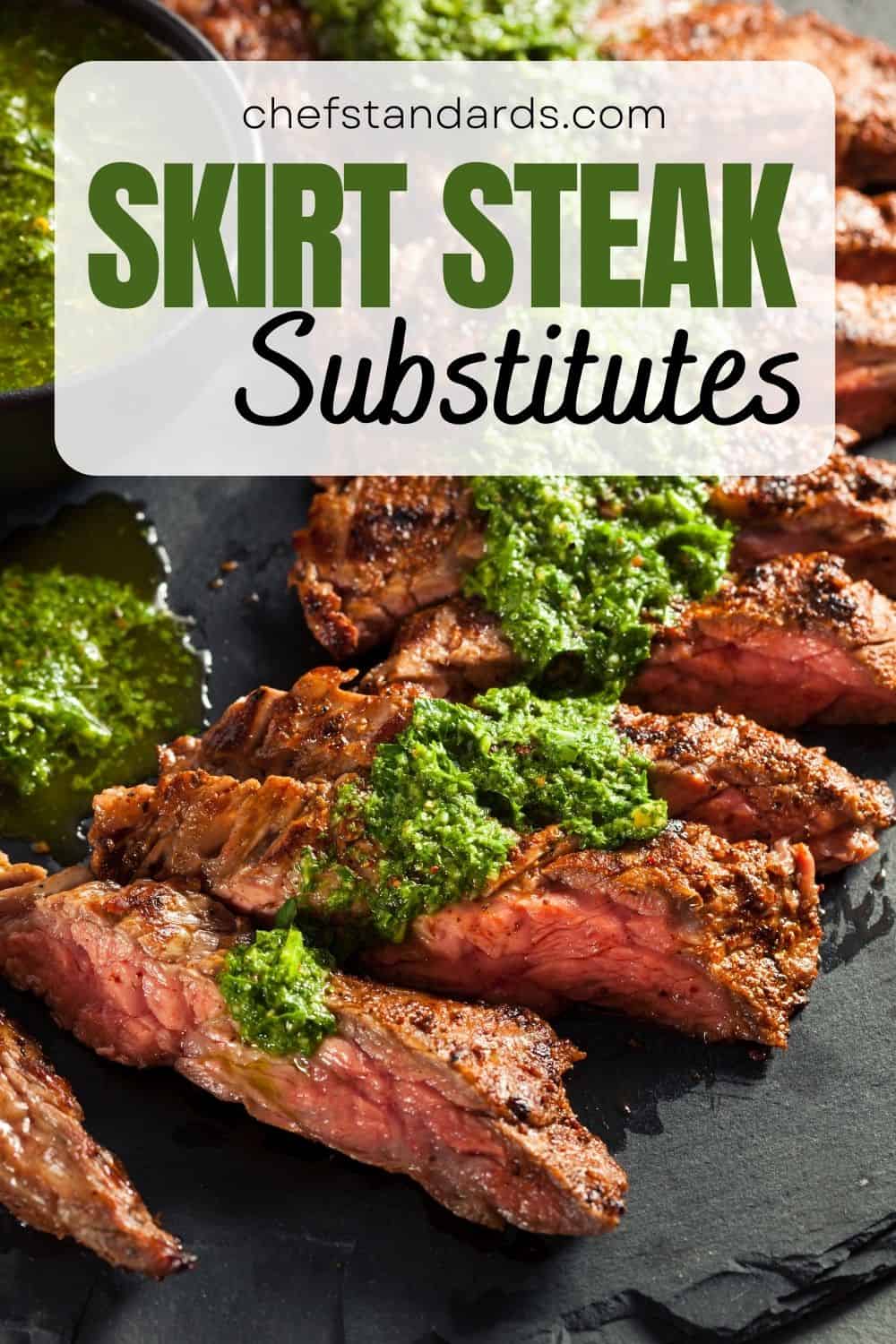I remember one sunny Saturday when I wanted to surprise my sister by preparing my favorite cut of beef – skirt steak. To my utter disappointment, I ran out of it. *heavy sigh*
Guess twice what I did next. Of course, I googled the best substitutes for skirt steak. Given that I’m skeptical by nature, I asked my friend James who is a chef in a prestigious restaurant to make me a list of the best skirt steak substitutes.
Now that I had the names of the substitutes, a few days later I decided to dig even deeper into the matter.
I was interested in how these cuts of beef differ from skirt steak and what they have in common. Of course, I was also interested in the ideal cooking methods and cooking temperature for each beef cut.
So, each substitute on the list is compared to skirt steak in terms of their similarities and differences. This helped me find the right substitute for my needs and preferences, and I’m sure it will be helpful to you, too.
You can thank me later! 😀
1. Flank Steak
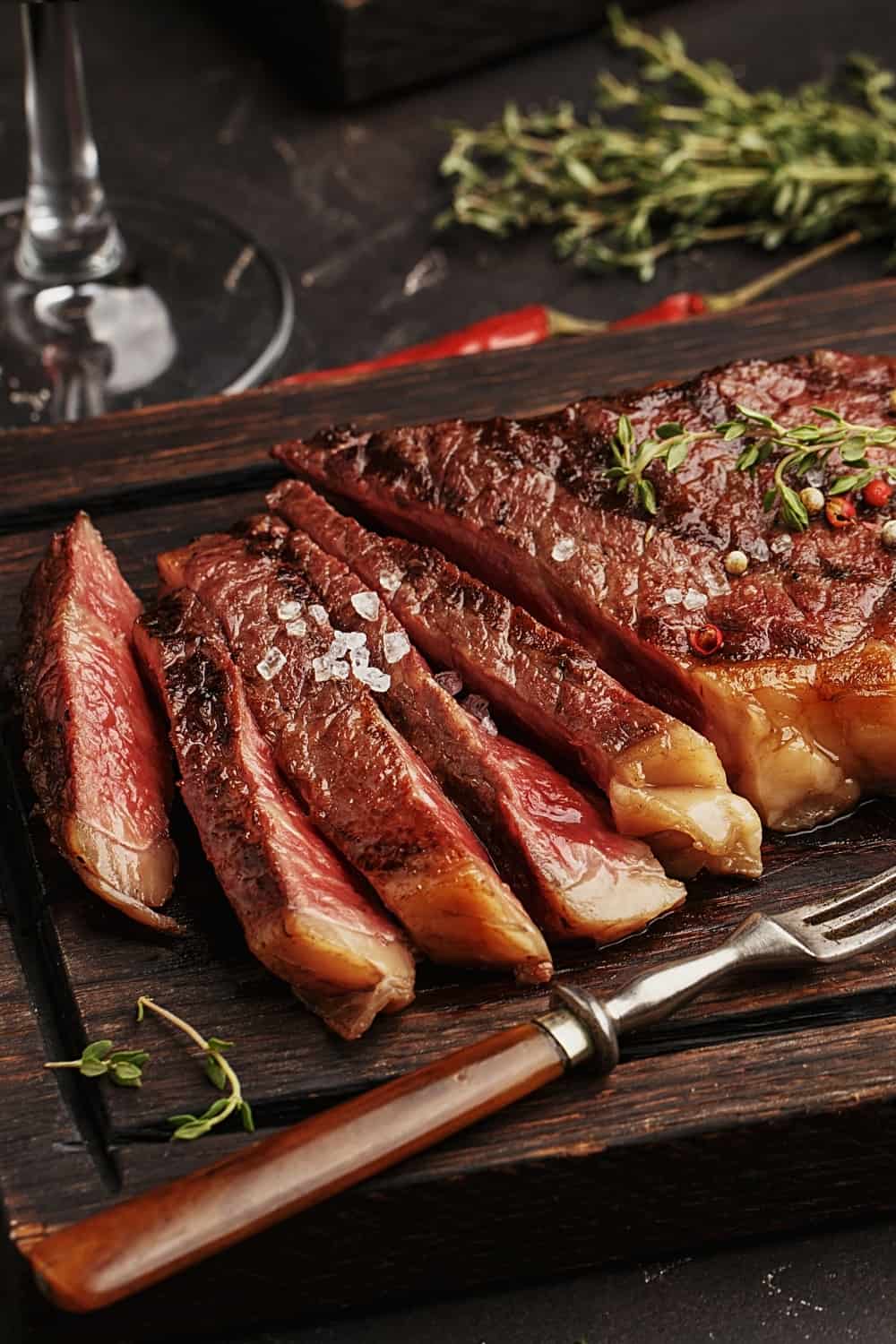
Flanks stand for the most used part of the cow, so there’s not much fat in this cut of beef.
Similarities
• Flavor: Both flank steak and skirt steak have strong beefy flavors.
Differences
• Location: Flank steak is cut from the abdominal muscles of the cow, whereas skirt steak is cut from the cow’s plate section.
• Appearance: Flank steak is rectangular in shape and doesn’t have much fat or marbling. Skirt steak is longer than flank steak and it’s well-marbled.
• Texture: Contrary to skirt steak, flank steak is not that tender cut of beef.
• Fat content: Flank steak has less fat than skirt steak. Flank steak has 8 g of fat per 100 grams, compared to skirt steak which has 12 g of fat per 100 grams.
• Cost: The average cost of flank steak is $14 per pound, while the average price of skirt steak is $16 per pound.
NOTE: According to the USDA, the minimum rest time for beef steaks is 3 minutes.
How to cook flank steak
Flank steak is great for grilling, stir-fries, fajitas, or broiling in the oven. This cut of beef is born to be marinated because of its rectangular (larger) shape which allows it to absorb more flavors.
The ideal degree of doneness: Rare to medium (120°-145 °F).
See Also: 16 Mouth-Watering Substitutes for Flank Steak To Enjoy
2. Sirloin Flap Steak
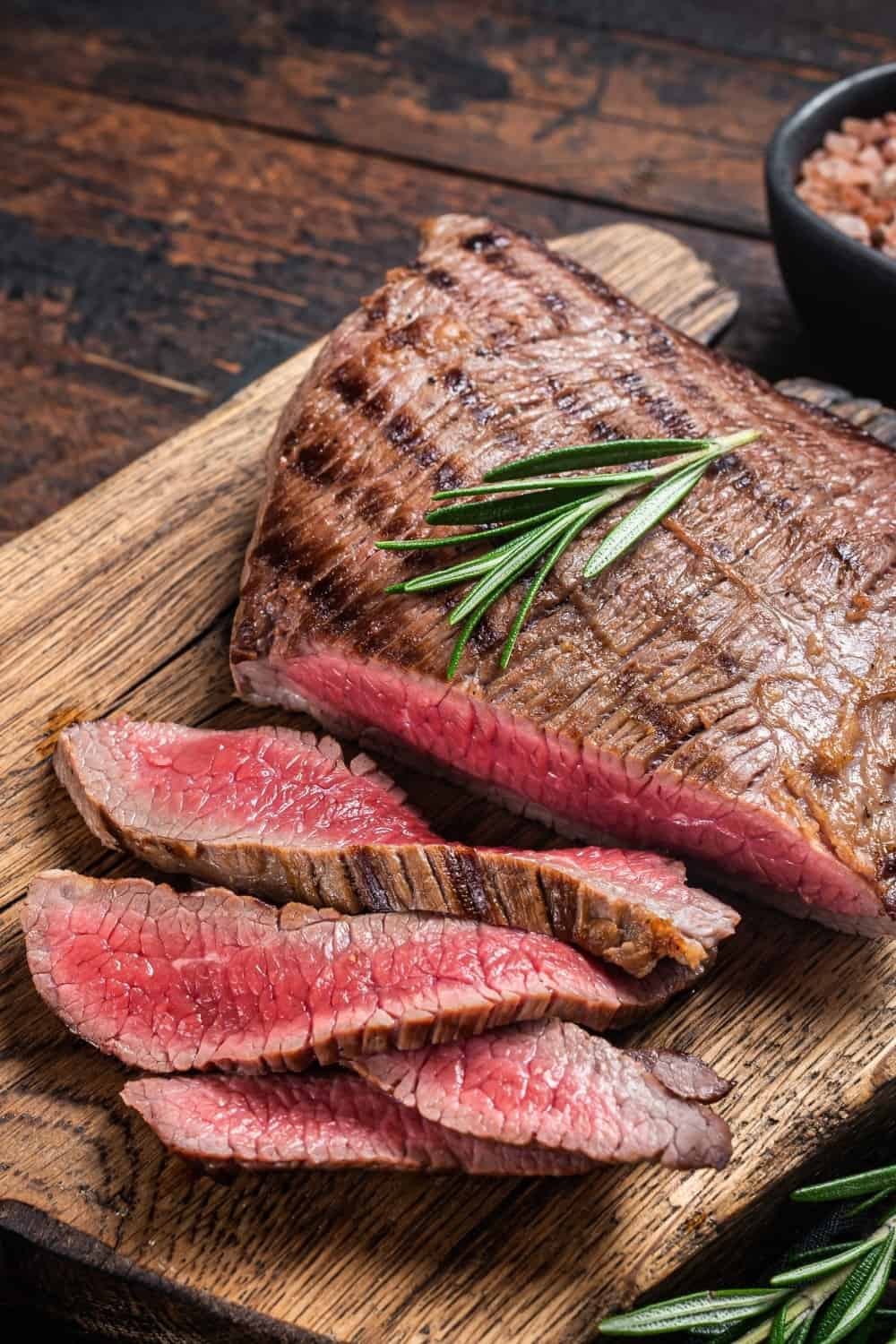
Sirloin flap steak is also known as sirloin tip or faux hanger.
Similarities
• Appearance: Both skirt steak and sirloin flap steak are long and a bit marbled. However, skirt steak is more purple than sirloin flap steak.
• Texture: Both sirloin flap steak and skirt steak have a tender texture.
• Flavor: Sirloin flap steak and skirt steak share a juicy and beefy flavor.
Differences
• Location: Sirloin flap steak is cut from the bottom of the sirloin, while skirt steak is cut from the cow’s plate section.
• Fat content: Sirloin flap steak has less fat than skirt steak. Sirloin flap steak has 6 g of fat per 100 grams, compared to skirt steak which has 12 g of fat per 100 grams.
• Cost: The average price for sirloin flap steak is $13 per pound, compared to $16 per pound for skirt steak.
How to cook sirloin flap steak
Sirloin flap steak is a versatile beef cut great for pan-searing, grilling, marinating, stir-fries, slow-cooking, or fajitas.
The ideal degree of doneness: Medium-rare to medium (130°-145°F) when it’s fast-cooked, or well done (160°-165°F) when it’s braised.
See Also: New York Strip vs Sirloin: 5 Major Differences Worth Knowing
3. Hanger Steak
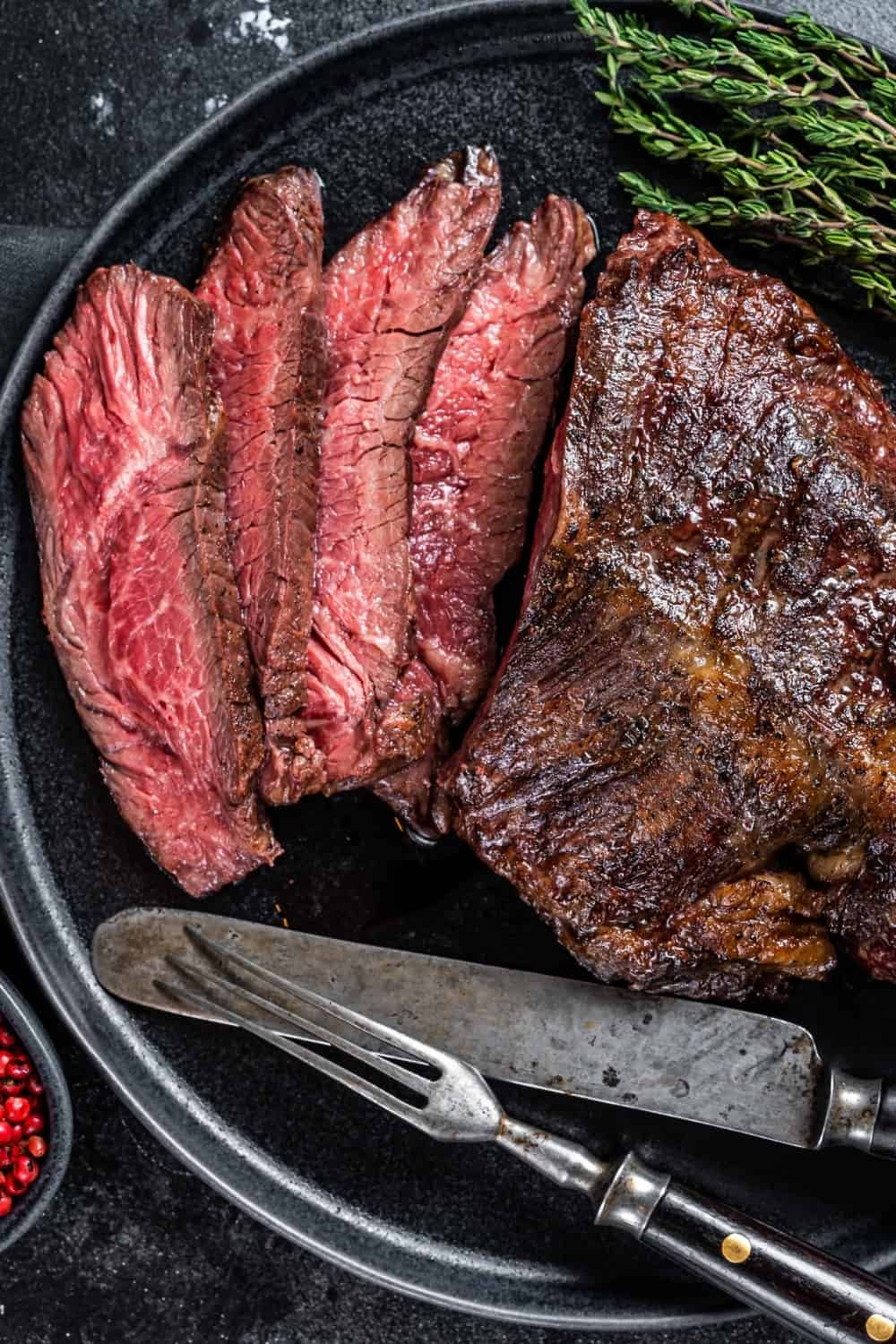
DID YOU KNOW? When people didn’t know to ask for hanger steak, butchers kept and enjoyed it for themselves. Hence, the original name of hanger steak was “butcher’s steak”.
Similarities
• Appearance: Both skirt steak and hanger steak are long, flat, and marbled. Also, they have a purple-ish color.
• Texture: Hanger steak and skirt steak share a tender texture.
• Flavor: Both hanger steak and skirt steak have a rich, juicy, and beefy flavor.
• Cost: Both hanger steak and skirt steak share the average price of $16 per pound.
Differences
• Location: Hanger steak is taken from the diaphragm of a cow, whereas skirt steak is cut from the cow’s plate section.
• Fat content: Hanger steak has 7 g of fat per 100 grams, whereas skirt steak has 12 g of fat per 100 grams.
How to cook hanger steak
Hanger steak can be grilled, pan-seared, marinated, stir-fried, or you can cook it sous-vide.
The ideal degree of doneness: Medium-rare to medium (130°-145°F).
If you aren’t sure how to trim or cooked hanger steak, then check out the video below:
4. Denver Steak

Sorry to disappoint you, but Denver steak doesn’t have any historical meaning. The name comes from a marketing concept that was unveiled in 2009.
Similarities
• Texture: Both Denver steak and skirt steak have a tender texture.
• Flavor: Denver steak and skirt steak share a juicy and beefy flavor.
Differences
• Location: Denver steak is cut from the shoulder of the cow, whereas skirt steak is cut from the cow’s plate section.
• Appearance: Denver steak is slightly thicker than skirt steak.
• Cost: The average cost of Denver steak is $15 per pound, whereas the skirt steak costs around $16 per pound.
• Fat content: Denver steak has a bit more fat than skirt steak. Denver steak has 16 g of fat per 100 grams, compared to 12 g for skirt steak.
How to cook Denver steak
Grilling, pan-searing, and stir-fries are some of the best cooking methods for Denver steak. Pro tip: Given that this beef cut is a bit thicker, make sure to adjust the cooking time accordingly.
The ideal degree of doneness: Rare (120°–125°F) and medium (140°–145°F).
5. Flat Iron Steak

Flat iron steak is also known as shoulder top blade steak, top blade steak, and top blade filet. For example, filet and sirloin are two quite similar parts of meat.
Similarities
• Flavor: Both flat iron steak and skirt steak have a juicy and beefy flavor.
Differences
• Location: Flat iron steak is taken from a cow’s chuck shoulder cold area, whereas skirt steak is cut from the cow’s plate section.
• Appearance: Flat iron steak has a rectangular shape, deep red color, and it’s marbled. Skirt steak has a long and flat appearance and a deep purple color.
• Texture: Flat iron steak is more tender than skirt steak.
• Fat content: Flat iron steak has 6 g of fat per 100 grams, while skirt steak has 12 g of fat per 100 grams.
• Cost: Flat iron steak is cheaper than skirt steak. The average price of flat iron steak is $9, while the average price of skirt steak is $16 per pound.
How to cook flat iron steak
Grilling, pan-searing, stir-fries, and marinating are the best cooking methods for flat iron steak.
The ideal degree of doneness: Rare (120°–125°F) and medium (140°–145°F).
6. Striploin Steak
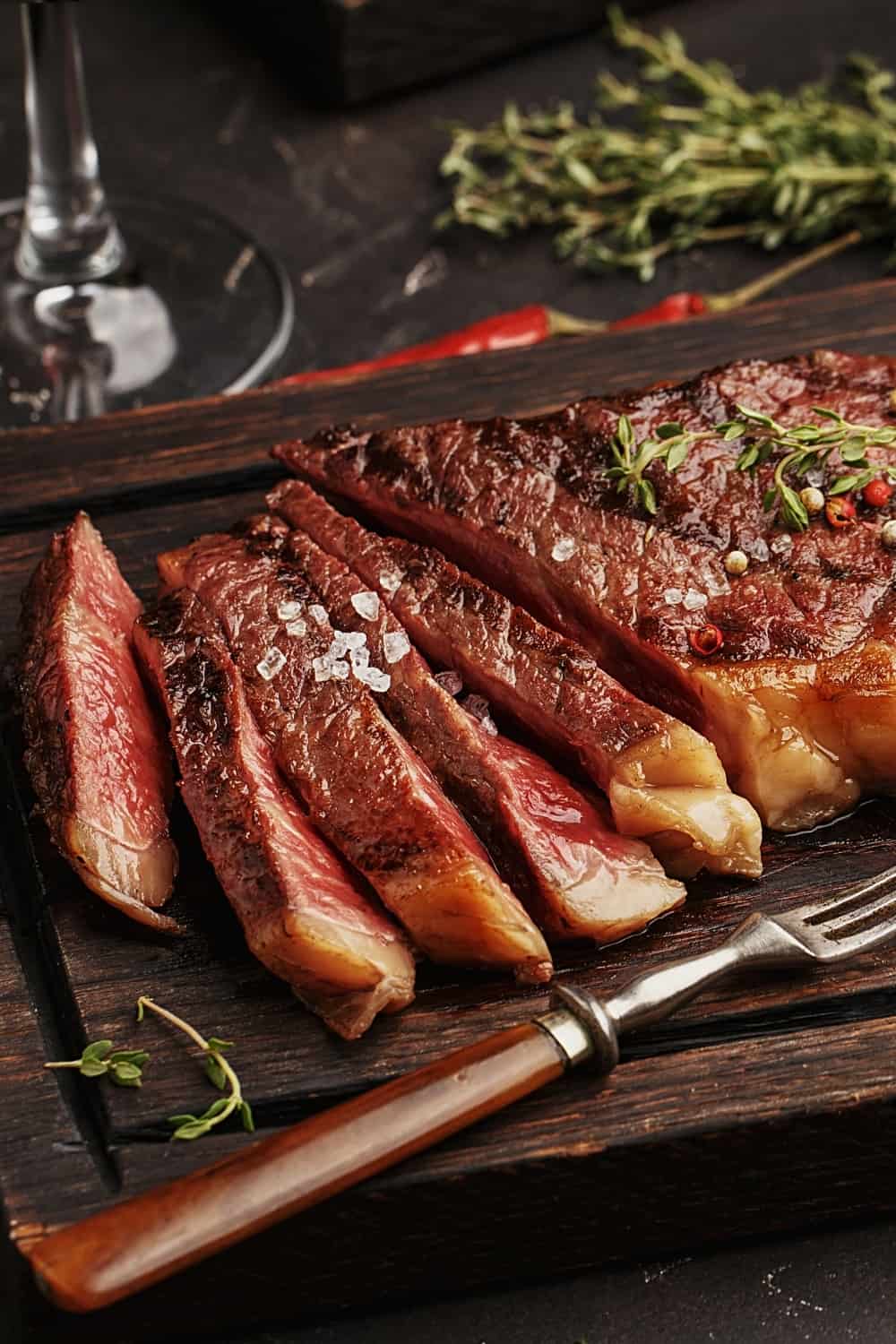
Striploin steak is somewhere in between the tenderloin and ribeye steak.
Similarities
• Flavor: Both striploin steak and skirt steak have a juicy and beefy flavor.
• Texture: Striploin steak and skirt steak share a tender texture.
Differences
• Location: Striploin steak is cut from the short loin (near the tenderloin), whereas skirt steak is cut from the cow’s plate section.
• Appearance: Striploin steak has a classic steak appearance and it’s well marbled, while skirt steak is longer.
• Fat content: Striploin steak has only 2.7 g of fat per 100 grams, compared to 12 g for skirt steak.
• Cost: The average cost of striploin steak is $20 per pound, while skirt steak costs around $16 per pound.
How to cook striploin steak
The ideal cooking methods for striploin steaks are grilling, pan-frying, and cooking in the oven.
The ideal degree of doneness: Rare (120°–125°F) and medium (140°–145°F).
7. Ribeye Steak
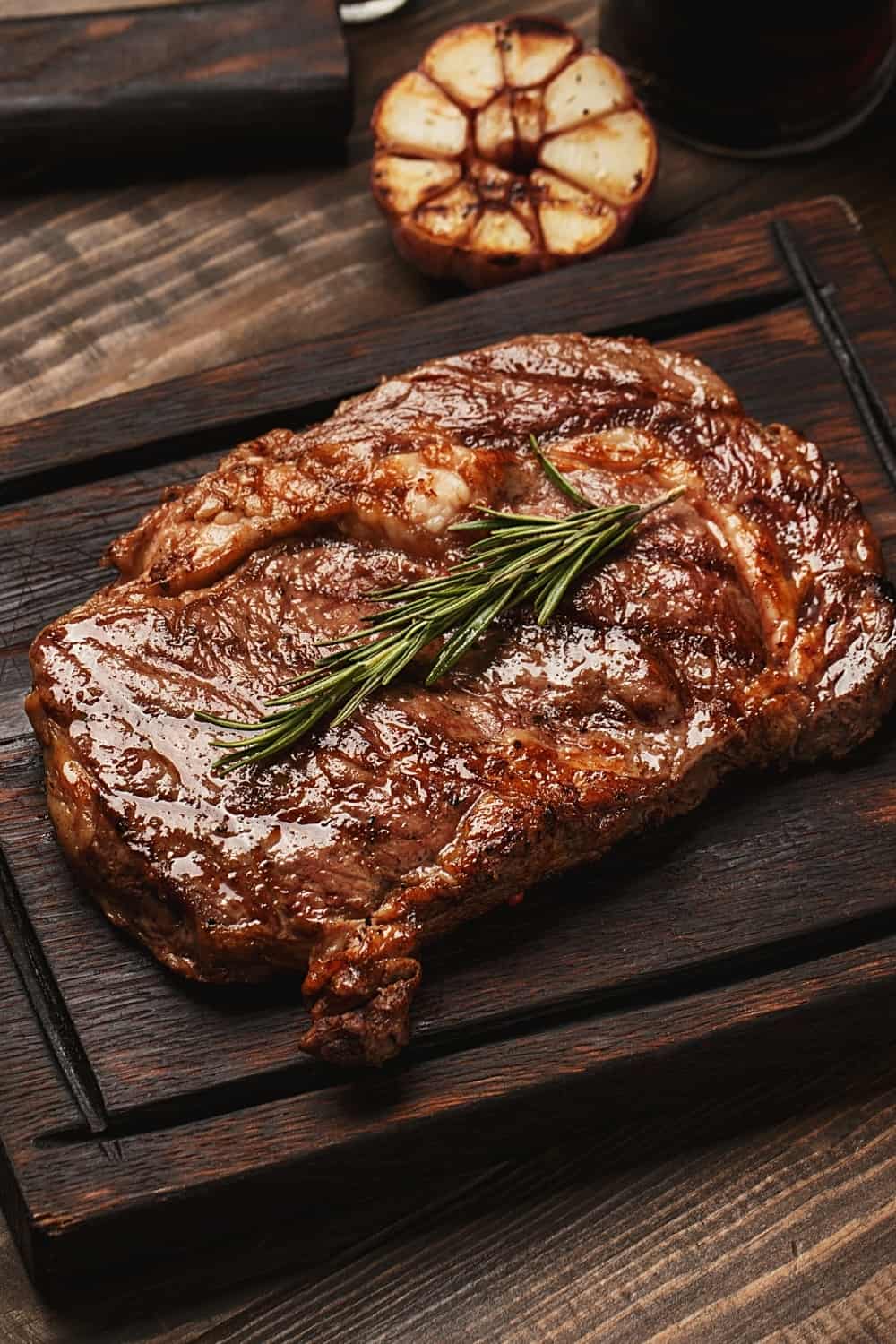
DID YOU KNOW? The name ribeye steak comes from its location (ribs) and shape which resembles an eye when boneless.
Similarities
• Texture: Both ribeye steak and skirt steak have a tender texture.
• Flavor: Ribeye steak and skirt steak share a juicy and beefy flavor.
Differences
• Location: As the name implies, ribeye steak is cut from the rib portion of the cow, while skirt steak is cut from the cow’s plate section.
• Appearance: Ribeye steak is thicker and has a deep red color, while skirt steak is longer and has a deep purple color.
• Fat content: Ribeye steak has more fat than skirt steak. Ribeye steak has 22 g of fat per 100 grams, while skirt steak has 12 g of fat per 100 grams.
• Cost: The average price of ribeye steak is $13 per pound, compared to $16 for skirt steak.
How to cook ribeye steak
The ideal cooking methods for striploin steaks are grilling, pan-frying, and cooking in the oven.
The ideal degree of doneness: Medium rare (130°–135°F).
Also, I’m sure you’re interested in how Gordon Ramsay makes the perfect ribeye in the video below:
Takeaway
Some steaks have a slightly different texture and flavor than skirt steak, but the majority of them can be prepared the same way as skirt steak (and are equally delicious).
When I was cooking for my sister, I chose a sirloin flap steak as a skirt steak alternative and it was delicious. At least, that’s what my sister said.
What’s your favorite skirt steak substitute? 🤔 Feel free to share.
